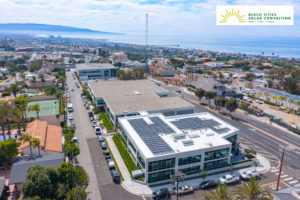Commercial Solar Workflow
California businesses tend to procrastinate going solar because they do not have any experience with California commercial solar workflow. They know it will save their company millions of dollars, and it is the right thing to do for the planet but are unsure of which providers to engage and how to size or specify a commercial solar system.
The entire process for a large business to go solar can take from 6-12 months depending on a variety of factors including the city your business is in and the utility that provides the electricity to your facility. There are eight steps in the California commercial solar project workflow process (System Sizing, Contracting, Site Audit, Permitting, Installation, Final Inspection, Commissioning, and Permission to Operate) and I will break them down into further detail here.
System Sizing: This is the first step of the process. Your company will need to engage a commercial solar company or consultant like Beach Cities Solar Consulting LLC to size a solar system for your facility based off the previous 12 months of consumption data and any future improvements to the facility that may add to its energy consumption (such as installation of electric vehicle charging infrastructure).
All commercial solar companies offer this service for free. For the solar installer to bid the project, your organization will need to provide 12 months electric utility bills, a picture of your electrical switchgear inside the facility, and a picture of your facility’s roof. The solar installer will provide a written proposal showing the layout of the solar system on the company’s roof or parking lot, the energy production the business can expect to receive from the solar system, and an estimate of the company’s electric utility bill savings.
One of the primary reasons large organizations hire Beach Cities Solar Consulting LLC is to manage this bidding process so they do not have to take time away from running their business trying to find and vet qualified providers. If financing is necessary, we use our extensive relationships in the industry to provide multiple offerings.
Contracting: After selecting a solar company (awarding the project) the business will select a form of payment for their solar system (lease, cash, or financed) and sign a contract for the installation of the solar system on their property as well as any relevant loan or lease documents necessary (if financing the solar system).
Site Audit: Once a signed contract is in place your solar installer will send a representative out to your facility to measure and mark the roof for the placement of the solar panels, inspect your main electrical panel and switchgear, and perform a shading analysis to ensure your solar panels have direct sunlight. The site audit typically takes about an hour, and the facilities director does not need to be on site. The results of the site audit are with the company’s management.
Permitting: After management approves the layout of the solar panels your solar installer will have a licensed engineer design plans for the commercial solar project to be built at your business’s facility. They will then submit the plans to the city’s building department in person or electronically if the city allows. The city or ‘Authorized Housing Jurisdiction’ (AHJ) will then review the plans to make sure they conform to all local codes prior to issuing a building permit for the solar system. This process can take between three to six months depending upon the AHJ and the size and complexity of the solar project.
Installation: The actual physical construction of the solar system by your solar installer. This can take between two to four weeks depending on the size of the solar system but may take longer if there is other work required for the solar system to be built (for example: a solar canopy structure or ground mount).
Final Inspection: An inspector from your AHJ will come to your facility to ensure that the solar system was installed according to code and is working properly. Your installer will have a representative meet the inspector on inspection day at your facility.
Commissioning: A representative from your solar installer and/or your electric utility will visit your facility to inspect the solar system prior to interconnecting the system to their electric grid. Upon commissioning the solar system, your commercial solar project will be producing clean, renewable solar energy!
Permission To Operate (PTO): After commissioning your commercial solar project, PTO is the ultimate step in the process. Your installer will provide all relevant utility paperwork including your Net Energy Metering Agreement to the utility. Your utility will process the paperwork and issue PTO, or permission to operate your solar system. Upon receiving notification of PTO from your utility, you are officially “interconnected” to the electric grid and your Net Energy Metering agreement takes effect. You will start to receive bill credits for any excess energy production sent to the grid from your solar system.
Want to see how much money your business or corporation can save with a commercial solar system? Get your turnkey solar proposal with ROI and financing options by e-mailing us your last 12 months’ electric bills (all pages), a picture of the electrical switchgear inside of the facility, and a picture of your roof today: info@beachcitiessolarconsulting.com.


